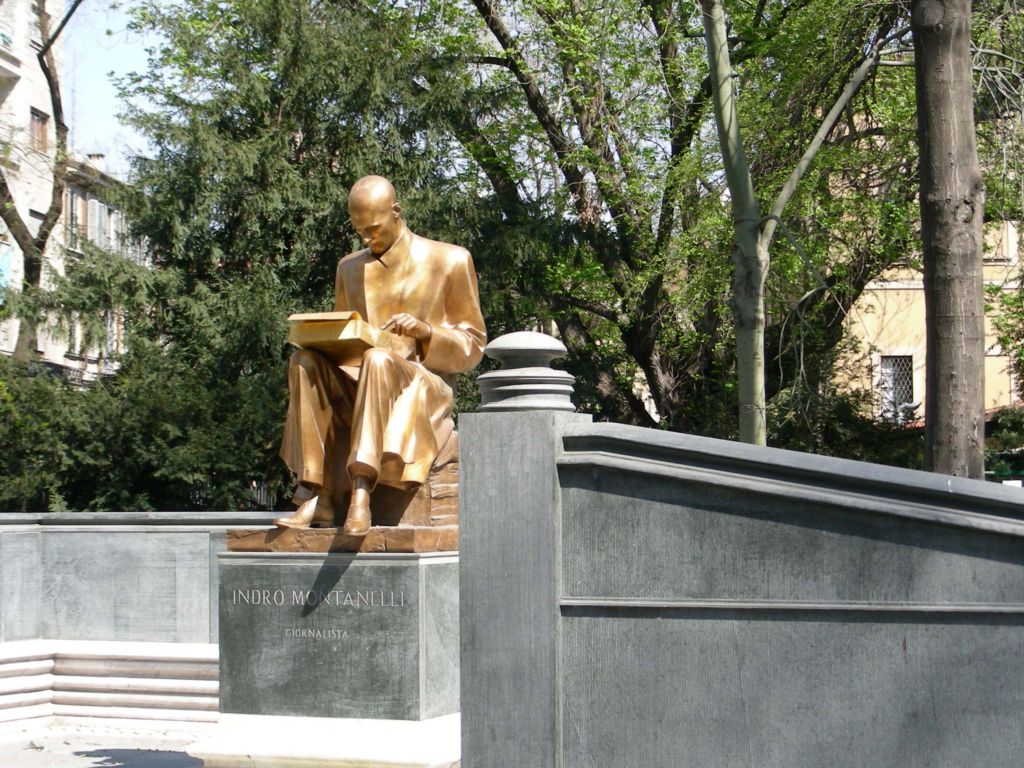None of us hopes for the war to end; we have only one desire: to continue!
Decades after his death, this has been the meaning of his past: a symbolic battleground. His statue in Milan has become the center of the ‘war’ between those defending him as an icon in journalism and others wanting to erase his colonial and – let’s be honest – controversial past. This debate, which seems endless, serves to underline how history itself wages battles over memory and identity and the figures we decide to commemorate.
Indro Montanelli: a controversial journalist
Indro Montanelli was one of the most important Italian Journalists from the 20th century. Initially a fascist sympathizer, he later grew critical of the regime and was struck off the register of journalists. He took part in the Second Italo-Ethiopian War, He taught Italian in Estonia and ran the Italian Cultural Institute in Tallinn before joining “Il Corriere della Sera” in 1938 as a reporter. After the fall of the fascist regime, he joined the “Giustizia e Libertà” partisans, was captured by the Germans, and later resumed his journalism career. He cofounded “Il Giornale” in 1974, before falling out with Berlusconi’s political ambitions in 1994 and founding the short-lived “La Voce“; it folded in 1995. He went back to work for “Il Corriere della Sera” and frequently appeared as a political commentator on many different television programs.
The Commemoration
The statue was commissioned by Milan’s then-mayor, Gabriele Albertini, inaugurated on May 22, 2006. Designed by Vito Tongiani, the monument shows Montanelli typing on an Olivetti typewriter, based on a picture by the famous photographer Fedele Toscani. The surrounding wall represents “La Stanza di Montanelli” (Montanelli’s Room), the title of his column, underlining his intellectual legacy, linked to Milan’s journalistic culture. Albertini is a great admirer of Montanelli, defining him as a “second father”, and wanted to stress his contribution to journalism and to Milan. At the time, there was little public opposition to Montanelli’s commemoration, reflecting the limited discourse about Italy’s colonial past. Albertini’s efforts were part of a broader initiative to honor figures associated with Milan’s and Italy’s conservative legacy. (Contested Histories 2-3).
The statue shows a simple inscription: “INDRO MONTANELLI, JOURNALIST”, a neutral way to commemorate this mine stone with no reference to his colonial past or other personal controversies.

The Contestation
While initial critiques focused on the statue’s design, due to a wrong representation of the dynamic nature of the journalist, later controversies centered on Montanelli’s colonialist past. In 1935, Indro Montanelli at the age of 26 was an officer in the Italian colonial army, and married a 12-year-old Eritrean girl named Destà, under the practice of “Madamato“, a mix of racism, human trade and violation of human rights allowed in Italian colonies. Montanelli expressed publicly his thoughts about the relationship with the girl, describing it as a regular move back in those days. He gave multiple time a clear description of what happened, talking about the prices these women-or children- had. Answering to one of his readers in his newspaper article, he said “It was not a real marriage, it was more as a leasing- a short term contract- with a price of 350 lire and 180 for a mud hut” (Indro Montanelli- La stanza di Montanelli). Montanelli also wrote in one of his biographical scripts “dentro la guerra” a quote that leaves little to the imagination:
No indulgences, no romances—only ‘The white man commands!

The anti-fascist group Sentinelli di Milano described the statue as “incompatible” with democratic values, and journalist Beppe Severgnini defended Montanelli’s work saying that his contributions to journalism should not be obliterated based on a single episode. Right party politicians such as Matteo Salvini opposed the statue’s removal, emphasizing Montanelli’s impact on Italian cultural history (Storie – di Antonio Lamorte). These acts were brought into sharper focus with the global Black Lives Matter movement in 2020, which reignited debates about monuments that commemorate controversial historical figures. Anti-racism groups such as Rete Studenti Milano, vandalized the statue condeming Montanelli as a colonial figure who “made slavery an important part of his political activity” (Statue of famous Italian journalist defaced in Milan – Al Jazeera). Nevertheless, authorities in Milan have defended it, arguing that the statue provides a vehicle for public discussion about Italy’s colonial past. (Contested Histories 3-5).

Where’s the monument today?
Despite calls for its removal and acts of vandalism, the monument still stands, while authorities prioritize public conversation and education over the erasing of history. This represents Italy’s struggle to reconcile its historical memory with contemporary social values. One more time, this is a clear example of how it doesn’t matter what kind of man you were and what atrocities you did, you were just “a man of that time”.
Resources
https://www.fondazionemontanelli.it/sito/pagina.php?IDarticolo=260
https://www.internazionale.it/opinione/francesca-coin/2020/06/17/statua-montanelli-italia-innocente
https://www.bbc.com/news/world-europe-53042350
https://www.britannica.com/place/Italian-East-Africa
Montanelli, I. (1936, January 1). Dentro la Guerra. Civiltà Fascista. https://www.storiologia.it/montanelli/montanelli.htm
L’Italia dell’Asse, 1a ediz. Rizzoli, 1981, pag 446 https://www.bibliorfeo.com/l-italia-dell-asse-1936-10-giugno-1940-31240.html
https://escholarship.org/uc/item/8bk357jd
https://www.fondazionemontanelli.it/sito/pagina.php?IDarticolo=228
Image reference
https://images.app.goo.gl/fapEpFK18WHa63Da6
